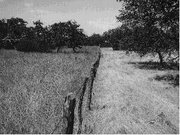Prairie Parkland (Subtropical) Province
Contents
Prairie Parkland (Subtropical) Province (Bailey)
West Gulf Coastal Plain, central lowlands, 80,100 mi2 (207,500 km2)
Land-surface form
This province is a region of gently rolling to flat plains, many of them part of the Gulf Coastal Plain. Over 50 percent of the area is gently sloping. Elevations range from sea level to 1,300 ft (400 m), with a local relief of less than 300 ft (90 m). Most of the Coastal Plain streams and rivers are sluggish; there are numerous wetland areas along the coast.
Climate
The climate is similar to that of the temperate prairies described above, except that winters are warmer and there is more precipitation, mostly in the form of rain instead of snow. Winters are warm (50 to 60F To 16C) and summers are hot (70 to 80F To 27C). Average annual precipitation ranges from 35 in (890 mm) in the north to 55 in (1,410 mm) in the south along the coast. Rain falls throughout the year, brought by on-shore winds in summer and by depressions in winter. Hurricanes are frequent in autumn. On the coast, the climate is almost without frost.
Vegetation
This region consists of prairies and savannas. Like the temperate prairies to the north, it is part of the grassland-forest transition area of the central United States. Due to aridity and probably also to fires and grazing, this area is dominated by various short and medium-to-tall grasses, along with a few hardy tree species. Trees are typically evergreen and are widely spaced and short of stature, rarely more than 25 ft (8 m) tall. Post oak and blackjack oak dominate the cross timbers region of Oklahoma and Texas. Hickories are common only in stands near the forest region. Soil is a key factor in local distribution. Fine, heavy soils generally support grassland vegetation, and coarse, lighter soils are covered with stands of savanna.
Bluestem is the principal grass throughout the region. The Gulf Coast of Texas has an extensive border of marshes stretching inland 5 to 10 mi (8 to 16 km), sometimes farther.
Soils
Mollisols, Alfisols, and Vertisols are the dominant soils. Dry Alfisols are found on the savannas, with Mollisols and Vertisols on the prairies.
Fauna
Whitetail deer are abundant, as is the nine-banded armadillo. The red wolf is classified as an endangered species (Endangered Species Act, United States).
The scissor-tailed flycatcher, eastern meadowlark, lark sparrow, and eastern and western kingbirds are indicator species of the region.
Return to Ecoregions of the United States
| Disclaimer: This article is taken wholly from, or contains information that was originally published by, the United States Forest Service. Topic editors and authors for the Encyclopedia of Earth may have edited its content or added new information. The use of information from the United States Forest Service should not be construed as support for or endorsement by that organization for any new information added by EoE personnel, or for any editing of the original content. |
